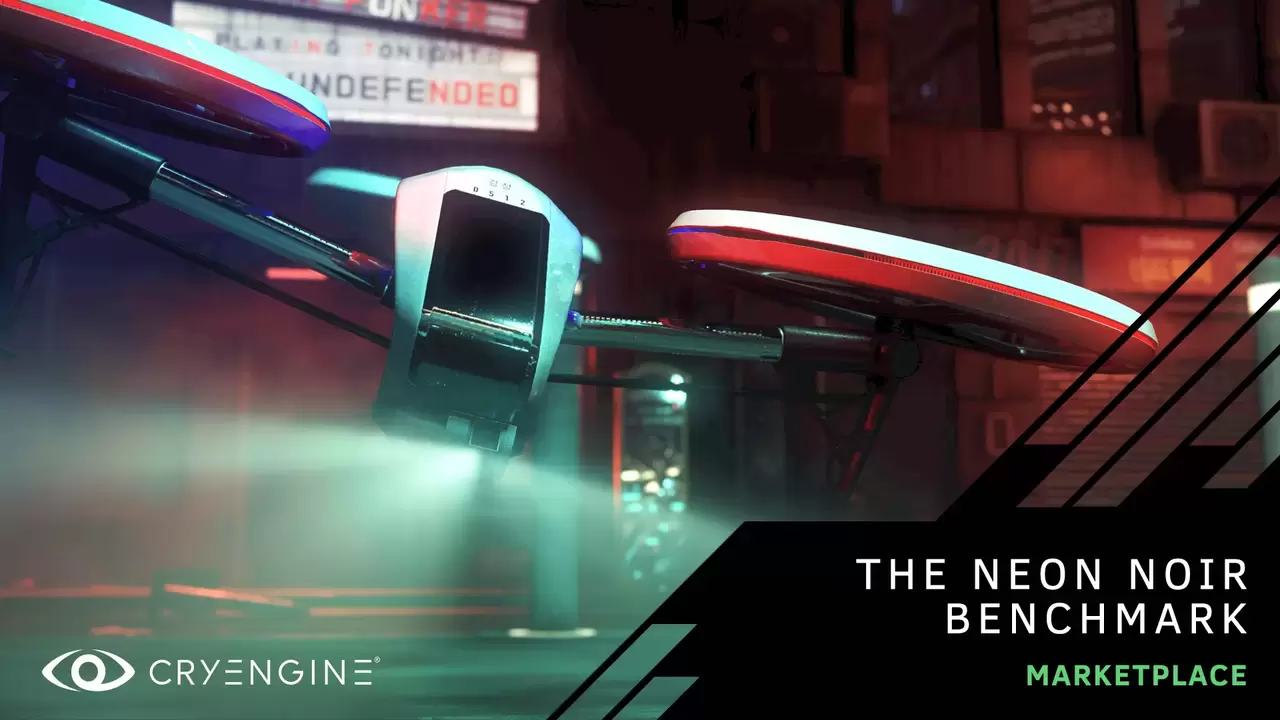New Benchmark Lets You Test Ray Tracing With AMD or Nvidia Graphics Cards
We ran Crytek's Neon Noir benchmark ourselves.

You might think that you need a fancy Nvidia RTX graphics card to demo ray tracing, but Crytek is here to prove us wrong. Its new Neon Noir benchmark is a ray-tracing demonstration that works on all modern-day graphics cards, including Nvidia’s Pascal architecture-based cards and AMD’s latest 5000-series graphics cards.
The Neon Noir ray tracing benchmark shows a drone flying through a dark rainy cityscape, where you can see reflections all around you on various glass panes, water puddles, broken mirror shards, wet objects and more. The drone itself even has its arms reflect on its own body – a subtle, but certainly enhancing, detail. Currently, however, the demo only uses ray tracing for reflections, not for shadows or ambient occlusion. Crytek said it will work on those features, however.
“The CRYENGINE ray tracing feature is both API and hardware-agnostic and runs on most mainstream, contemporary AMD and Nvidia GPUs” claims Crytek.
As a consequence of creating a ray tracing feature that doesn’t require Nvidia RT cores, performance is significantly better across the board with ray tracing enabled on non-RTX graphics cards, and GPUs with RT cores won’t have much of a benefit beyond what their GPU’s architecture would offer anyway.
Minimum Tech Requirements
Crytek recommends you have a minimum of an AMD Ryzen 5 2500X or Intel Core i7-8700 CPU, along with an AMD Vega 56 or Nvidia GTX 1070 GPU and 16GB of RAM.
Running the Benchmark
We quickly ran the benchmark on a system equipped with an AMD Ryzen 7 1800X CPU, (which doesn't meet the minimum recommendation), paired with an RTX 2070 Super graphics card at 4K resolution. With the ray tracing setting set to Very High, we got some great-looking visuals and smooth framerates hovering around the 37 frames per second (fps) mark, with a minimum of 32 fps and maximum of 41 fps.
Setting ray tracing feature to Ultra netted roughly a 10 fps penalty and did make the demo quite stuttery.
Get Tom's Hardware's best news and in-depth reviews, straight to your inbox.
If you want to have a look at the demo, you can install it by making an account at Crytek, downloading the CryEngine launcher and the Neon Noir benchmark at the Crytek marketplace for free.
Having implemented this feature in the new 2020 CryEngine that's due to ship soon, Crytek will continue to experiment to see how far they can take the feature.
Niels Broekhuijsen is a Contributing Writer for Tom's Hardware US. He reviews cases, water cooling and pc builds.
-
The Net Avenger 1) Crytek is not doing full ray tracing. It is only ray tracing highly reflective surfaces from lower resolution geometry. This leaves out shadows, and also isn't applied to rough materials.Reply
2) Agnostic GPU Acceleration - Yes, but not unique to Crytek. DXR is also GPU agnostic. The RTX ray tracing drivers from NVidia are simply using DXR features on the older hardware. NVidia could implement ray tracing on even older video cards, but it would be slow. - Also note that AMD is working on DXR drivers for their current GPUs, with hardware specific features for ray tracing coming in the next generation, which is the GPU that will appear in the PS5 and XBox 2020.
I think what Crytek are doing is great. Every technique to get ray tracing effects and ways to speed up ray tracing are always a really good thing, as 'realism' in games is not about pixel count, but about lighting.
However, for now, this technology might be limited to gaming, as it cannot do realistic ray tracing. My second concern is they could fragment game development, by not offering the same ray tracing concepts that other real-time technologies all use.
Also, it seems odd that instead of building from DXR and DX12, they instead are building from DX11, which is not as fast or efficient. This is especially strange for a technology like Ray Tracing that needs multi-core to GPU communication that DX11 doesn't do well. Besides, DX11 'only' GPUs are quite old in 2019, and there doesn't seem to be a good reason to target those GPUs for something that is still has a heavy cost on performance.
DXR is a Microsoft technology, but they have helped Vulkan implement nearly all the features, so that developers don't have to lock themselves into Windows. (Which is quite something to see from Microsoft.) -
bit_user Reply
Thanks. Now, how about telling us what framerates it hit!hannibal said:Did try it with 3700x and 5700xt... quite impressive. -
hannibal Ok. New version with chrome effects, seems to be little bit harder than previous versionReply
At ultra level of course :) at 1080p 65-110 fps result 7846
also at ultra 1440p 35-65 fps result 4747
3700x and 5700xt. No overclocking so stock settings both.

